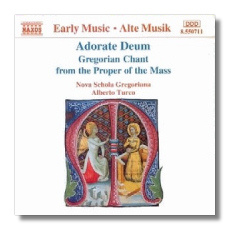
The Internet's Premier Classical Music Source
Related Links
- Latest Reviews
- More Reviews
-
By Composer
-
Collections
DVD & Blu-ray
Books
Concert Reviews
Articles/Interviews
Software
Audio
Search Amazon
Recommended Links
Site News
 CD Review
CD Review
Adorate Deum

Gregorian Chant from the Proper of the Mass
Nova Schola Gregoriana/Alberto Turco
Naxos 8.550711 1993 DDD 75:25
You can never step in to the same river twice. While Gregorian chant is a deposit of Latin liturgical music in many historical strata, it gave the impression to uninitiated listeners of at least my generation of being a unified, undifferentiated corpus. And back in the years when the ultimate source seemed to be that massive monolith, the Liber usualis, many of us were uninitiated listeners, with only a vague understanding of how those serene, hypnotic melodies in the Liber actually corresponded to the manuscripts from which they were drawn. Of course, we knew from history books that there were other ways of interpreting the archaic-looking neumes than the official Solemnes method set forth in the Liber's preface, but at that time the chant was a part of our daily lives, and its very pervasiveness in the official form precluded much experimentation. But not investigation. While parish choirs were singing, theorists debated the merits of various hypotheses purporting to represent the original rhythmic structure of the multiform neumes (the official doctrine held that they were all more or less equal, with some more equal than others). Now that the church has practically abandoned its treasure-house of liturgical monody (and polyphony), there is room for more experimentation in performance. It hasn't taken musicologists long to fill that room with singing.
The present disc, featuring performances following the teachings of Dom Cardine, makes a strong case for his artistic, if not academic, premises. Including selections of Introitus, Gradualia, Versus alleluiatici, Offertoria, and Communiones – all texts from the proper, or changeable, parts of the Mass – alberto Turco, a lecturer in Gregorian chant in the Pontifical Ambrosian Institute of Sacred Music in Milan, has assembled a showcase for this alternative performance style. Those of us who remember Gregorian chant as ethereal wisps of melody floating serenely above the liturgical action at the altar, or as a dry musicological exercise (in a doctoral seminar, I traced skeletal introit melodies through their varied reincarnations in manuscripts of diverse geographical origin) these performances breathe new life into the ancient, mummified body that we all revered out of duty but only occasionally loved. The recent spate of such alternative performances has now revealed to everyone how multiramified the Gregorian tree really was, and how much of the changing historical river was concealed beneath the smooth flow in the liturgical books.
Turco strongly differentiates the melismatic (heavily ornamental) sections from the syllabic (one note per syllable) ones. The former are characterized by coherent rhythmic groupings and resonant quasi-drones. The latter are sung in the old, familiar style. But it is the melismatic chant that dominates this collection – and provides such a fresh perspective on this music. Of course, the chant still seems incomplete when severed from the liturgical action, but no style of performance can remedy that.
Turco's "Nova Schola Gregoriana," recorded in the reverberant acoustic ambience of the Church of the Nativity of the Blessed Virgin in Mantua, give warm, heartfelt performances of the repertoire they have chosen. These adjectives could hardly ever have been used in praise of a Solemnes performance, which, despite its French provenance, always somehow conjured the aridity of a cassocked Vatican bureaucrat. The all-male choir recreates the monastic matrix of these ageless chants, which seem youthfonce again in their new idiom.
This is another stunning release by Naxos, which should appeal to absolutely everyone. It is a journey of the soul to the origins, and we all need such a journey. Urgently recommended.
Copyright © 1996, Robert Maxham


















